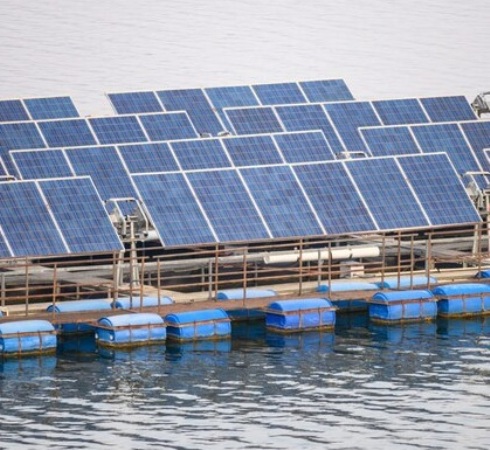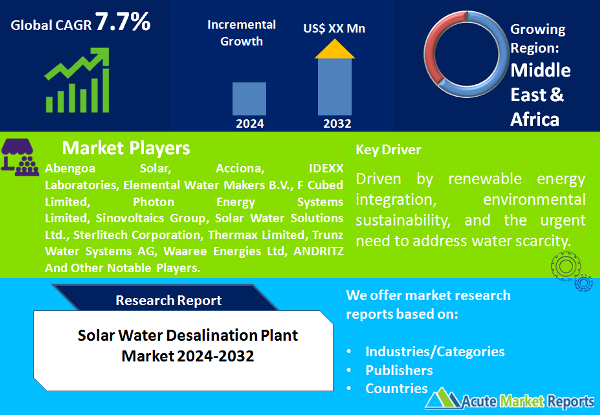
The solar water desalination plant market is a critical and innovative segment in the field of clean water production. The solar water desalination plant market is expected to experience a CAGR of 7.7% during the forecast period, driven by renewable energy integration, environmental sustainability, and the urgent need to address water scarcity. While high initial capital costs present a significant restraint, the market is expected to expand, especially in regions where solar desalination aligns with water supply challenges and sustainability goals. The competitive landscape is marked by key players committed to delivering eco-friendly and reliable water solutions and adapting to the changing needs of communities and industries.

Renewable Energy Integration
Solar Power Synergy: One of the primary drivers propelling the solar water desalination plant market is the integration of renewable energy sources, particularly solar power. In 2024, there was a substantial increase in the use of solar energy for desalination processes. Solar desalination plants have gained prominence due to their ability to harness abundant solar energy, reducing operational costs and environmental impact. This trend is expected to continue into the forecast period from 2025 to 2033 as renewable energy becomes more integral to global clean water production.
Energy Independence and Grid Resilience: The growing emphasis on energy independence and grid resilience is another significant driver. In 2024, regions prone to water scarcity explored solar water desalination as a means to secure their water supply independently of centralized power grids. Solar desalination plants offer a decentralized and reliable solution, particularly in remote or disaster-prone areas. This trend is anticipated to persist during the forecast period as communities and industries seek energy-efficient and self-sustaining water sources.
Environmental Sustainability
Reducing Carbon Footprint: The second key driver is the commitment to environmental sustainability. In 2024, concerns over climate change and environmental impact led to increased adoption of solar desalination. These plants produce fresh water with a significantly lower carbon footprint compared to traditional desalination methods. This trend is expected to continue into the forecast period, with governments, industries, and environmental organizations promoting solar-powered desalination as a responsible and eco-friendly approach
Water Scarcity Mitigation
Addressing Water Scarcity: The third driver is the urgent need to address water scarcity. In 2024, regions experiencing water scarcity, particularly in arid climates, invested in solar water desalination as a strategic solution. These systems provide a reliable source of fresh water, even in challenging environments, and contribute to mitigating water stress. This trend is anticipated to persist during the forecast period as water scarcity remains a pressing global issue, and solar desalination proves its effectiveness.
High Initial Capital Costs
Financial Barrier: A significant restraint impacting the solar water desalination plant market is the high initial capital costs. In 2024, the upfront expenses associated with the establishment of solar desalination plants were a barrier for some potential adopters. These costs encompass the purchase of solar panels, desalination equipment, and infrastructure. This restraint is expected to persist during the forecast period, especially in regions with limited financial resources. Addressing this challenge requires innovative financing models and cost-reduction measures.
Method (Direct, Indirect): Direct Methods Dominate the Market
In 2024, direct solar water desalination methods recorded the highest revenue due to their efficiency and ability to convert solar energy directly into fresh water. However, during the forecast period from 2025 to 2033, the indirect method is expected to exhibit the highest compound annual growth rate (CAGR). Indirect methods, which involve the use of solar energy for electricity generation and subsequent desalination, offer a more flexible and scalable approach. While direct methods are expected to maintain their revenue leadership, indirect methods are likely to experience rapid growth due to their adaptability.
End-Use Levels (Industrial, Agriculture, Commercial, Municipal): The Industrial Sector Dominates the Market
In 2024, the industrial sector recorded the highest revenue due to its significant water requirements for various processes. However, during the forecast period from 2025 to 2033, the municipal sector is expected to exhibit the highest CAGR. Municipalities are increasingly adopting solar desalination to ensure a sustainable and decentralized water supply for their communities. While the industrial sector is expected to maintain its revenue leadership, the municipal sector is poised for substantial growth.
Middle East and Africa Remain as Global Leaders
The geographic trends in the solar water desalination plant market indicate that regions with high solar irradiance and severe water scarcity, such as the Middle East and Africa (MENA) region, witnessed substantial growth in 2024. These regions are also expected to continue experiencing the highest CAGR during the forecast period. Additionally, North America, particularly areas with both ample sunlight and water challenges, is another region with significant revenue percentages in 2024 and is expected to maintain this position during the forecast period, driven by the integration of solar desalination into water management strategies.
Market Competition to Intensify during the Forecast Period
In the competitive landscape of the solar water desalination plant market, key players such as Acciona, IDEXX Laboratories, Abengoa Solar, Elemental Water Makers B.V., F Cubed Limited, Photon Energy Systems Limited, Sinovoltaics Group, Solar Water Solutions Ltd., Sterlitech Corporation, Thermax Limited, Trunz Water Systems AG, Waaree Energies Ltd, and ANDRITZ have been at the forefront of innovation and product development. These companies have consistently invested in research and development to enhance their desalination technologies and have formed strategic partnerships with local governments and utilities to implement solar desalination solutions. In 2024, these industry leaders secured substantial revenue shares, and they are expected to maintain their positions during the forecast period from 2025 to 2033. Their strategies encompass deploying solar desalination plants in regions with severe water scarcity, engaging in pilot projects to demonstrate effectiveness, and collaborating with governments and international organizations to drive policy support for solar water desalination. Moreover, they are actively involved in addressing high capital costs by exploring financing options and innovative business models
Historical & Forecast Period
This study report represents analysis of each segment from 2023 to 2033 considering 2024 as the base year. Compounded Annual Growth Rate (CAGR) for each of the respective segments estimated for the forecast period of 2025 to 2033.
The current report comprises of quantitative market estimations for each micro market for every geographical region and qualitative market analysis such as micro and macro environment analysis, market trends, competitive intelligence, segment analysis, porters five force model, top winning strategies, top investment markets, emerging trends and technological analysis, case studies, strategic conclusions and recommendations and other key market insights.
Research Methodology
The complete research study was conducted in three phases, namely: secondary research, primary research, and expert panel review. key data point that enables the estimation of Solar Water Desalination Plant market are as follows:
Market forecast was performed through proprietary software that analyzes various qualitative and quantitative factors. Growth rate and CAGR were estimated through intensive secondary and primary research. Data triangulation across various data points provides accuracy across various analyzed market segments in the report. Application of both top down and bottom-up approach for validation of market estimation assures logical, methodical and mathematical consistency of the quantitative data.
| ATTRIBUTE | DETAILS |
|---|---|
| Research Period | 2023-2033 |
| Base Year | 2024 |
| Forecast Period | 2025-2033 |
| Historical Year | 2023 |
| Unit | USD Million |
| Segmentation | |
Method
| |
Capacity (Cubic Meter/Day)
| |
Technology
| |
End-Use
| |
|
Region Segment (2023-2033; US$ Million)
|
Key questions answered in this report